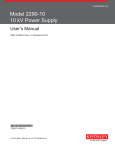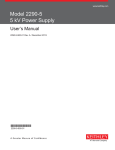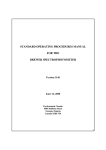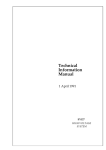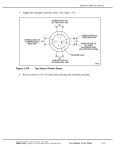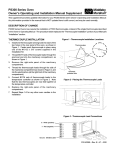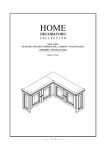Download PS355 - Stanford Research Systems
Transcript
Operation and Service Manual High Voltage Power Supplies PS355, PS365, PS370, PS375 Stanford Research Systems Revision 1.0 · December, 2008 Certification Stanford Research Systems certifies that this product met its published specifications at the time of shipment. Warranty This Stanford Research Systems product is warranted against defects in materials and workmanship for a period of one (1) year from the date of shipment. Service For warranty service or repair, this product must be returned to a Stanford Research Systems authorized service facility. Contact Stanford Research Systems or an authorized representative before returning this product for repair. Contact Information Stanford Research Systems, Inc. 1290-D Reamwood Avenue Sunnyvale, CA 94089 USA Phone: (408)744-9040 Fax: (408)744-9049 www.thinkSRS.com [email protected] Information in this document is subject to change without notice. Copyright © Stanford Research Systems, Inc., 2008. All rights reserved. Printed in U.S.A. Document number: 9-01637-903 Stanford Research Systems PS300 Series High Voltage Power Supplies Contents General Information . Symbols . . . . . . . . Notation. . . . . . . . Specifications . . . . . . . . . . . . . . . . . . . . . . . . . . . . . . . . . . . . . . . . . . . . . . . . . . . . . . . . . . . . . . . . . . . . . . . . . iii iv v vi 1 Instrument Overview . . . . . . . . . . . . . . . . . 1.1 Front Panel . . . . . . . . . . . . . . . . . . . . 1.2 Rear Panel . . . . . . . . . . . . . . . . . . . . 1–1 1–2 1–3 2 Guide to Operation . . . . . . . . . 2.1 Se ing Parameters . . . . . . . 2.2 Reset. . . . . . . . . . . . . . . 2.3 Store and Recall . . . . . . . . 2.4 Error Messages. . . . . . . . . 2.5 Analog Monitor and Control . 2.6 Default State . . . . . . . . . . . . . . . . . . . . . . . . . . . . . . . . . . . . . . . . . . . . . . . . . . . . . . . . . . . . . . . . . . . . . . . . . 2–1 2–2 2–3 2–3 2–4 2–4 2–5 3 Remote Operation . . . . . . . . . . . 3.1 Index of Common Commands . 3.2 Alphabetic List of Commands . 3.3 Introduction . . . . . . . . . . . 3.4 Commands . . . . . . . . . . . . 3.5 Status Model . . . . . . . . . . . 3.6 Status Reporting . . . . . . . . . . . . . . . . . . . . . . . . . . . . . . . . . . . . . . . . . . . . . . . . . . . . . . . . . . . . . . . . . 3–1 3–2 3–3 3–4 3–4 3 – 12 3 – 13 4 Troubleshooting . . . . . . . . . . . . . . . . . . . . 4.1 Troubleshooting the PS300 . . . . . . . . . . . 4–1 4–2 i ii Contents Stanford Research Systems PS300 Series High Voltage Power Supplies General Information The PS300 Series High Voltage Power Supplies are general purpose instruments designed for laboratory environments. Warning This unit contains hazardous high voltages. Make certain the high voltage is completely discharged before removing the cable. The charge on the cable can cause injury or damage. Line Voltage The PS300 series supplies operate from a 90 VAC to 264 VAC power source having a line frequency between 47 Hz and 63 Hz. Power consumption is less than 80 VA total. A power entry module, labeled AC POWER on the back panel of the PS300, provides connection to the power source and to a protective ground. The PS300 uses a detachable, three-wire power cord for connection to the power source. The exposed metal parts of the box are connected to the power ground to protect against electrical shock. Always use an outlet which has a properly connected protective ground. The rear-panel high voltage connector and the BNC shields are also connected to chassis ground. The PS300 series supplies CANNOT be floated. The line fuse is internal to the instrument and may not be serviced by the user. Operate only with covers in place to avoid personal injury. Do not remove the product covers or panels. Do not operate the product without all covers and panels in place. Service The PS300 does not include any user-serviceable parts inside. Refer service to a qualified technician. iii iv Contents Symbols you may find on SRS products Symbol Description Alternating current Caution - risk of electric shock Frame or chassis terminal Caution - refer to accompanying documents Earth (ground) terminal Battery Fuse On (supply) Off (supply) Stanford Research Systems PS300 Series High Voltage Power Supplies v Contents Notation Typese ing conventions used in this manual are as follows: · Front-panel bu ons are represented as [Bu on] · The [▲] and [▼] keys increment and decrement a digit. · The [◄] and [►] keys select a digit. · Front-panel indicators are represented as Overload · The state of a switch is represented in italics as ON · Remote command names are represented as *IDN? · Literal text other than command names is represented as OFF Remote command examples will all be set in monospaced font. In these examples, data sent by the host computer is set as straight teletype font, while responses received by the host computer are set as slanted teletype font. PS300 Series High Voltage Power Supplies Phone: (408)744-9040 www.thinkSRS.com vi General Information Specifications Model Output Voltage (±) Maximum Current PS355 PS365 PS370 PS375 -100 V to -10 kV +100 V to +10 kV -100 V to -20 kV +100 V to +20 kV 1 mA 1 mA 500 µA 500 µA Voltage Output Voltage set accuracy Voltage display accuracy Voltage resolution Voltage rese ability Voltage limit range Voltage regulation Output ripple (rms) Current limit range Current trip range Trip response time Current set accuracy Current resolution Current display accuracy Stability Temperature dri Protection HV output slew rate Recovery time Discharge time 0.01 % + 0.05 % of full scale Vset accuracy ± 1 V, typ. (± 2 V, max.) 1 V (set and display) 1V 0 to 100 % of full scale 0.001 % for ±10 % line change, 0.04 % for 100 % load change. Specifications apply for >0.5 % (full load) to >1 % (no load) of full-scale voltage. <0.01 % of full scale (max.) 0 to 105 % of full scale 0 to 105 % of full scale <10 ms 1 µA 1 µA ±1 µA (typ.), ±2 µA (max.) 0.01 % per hr., <0.03 % per 8 hrs. 50 ppm/°C, 0 to 50 °C (typ.) Arc and short circuit protected (programmable voltage limit, current limit, and current trip) 7,000 V/s, typ. (PS355 and PS365) 14,000 V/s, typ. (PS370 and PS375) 12 ms for 40 % step change in load current (typ.) <6 s (to <1 % of full-scale voltage with no load, typ.) Monitor Output Output scale Current rating Output impedance Stanford Research Systems 0 to +10 V (0 to full-scale output regardless of polarity) 10 mA (max.) <1 Ω PS300 Series High Voltage Power Supplies vii General Information Accuracy Update rate 0.2 % of full scale 87.5 Hz External Voltage Set Input scale Input impedance Accuracy Update rate 0 to +10 V (0 to full-scale output regardless of polarity) 1 MΩ 0.2 % of full scale 87.5 Hz Mechanical HV connector Mating connector Dimensions Weight Power Warranty Kings type 1064-1 (PS355 and PS365) Kings type 1764-1 (PS370 and PS375) Kings type 1065-1 (PS355 and PS365) Kings type 1765-1 (PS370 and PS375) 8.1″ × 3.5″ × 16″ (WHD) 8 lbs. 50 W, 90 to 264 VAC, 47 to 63 Hz One year parts and labor on defects in materials or workmanship All performance specifications apply aĞer a one hour warm-up period PS300 Series HighVoltage Power Supplies Phone: (408)744-9040 www.thinkSRS.com General Information PS300 Series HighVoltage Power Supplies viii Phone: (408)744-9040 www.thinkSRS.com 1 Instrument Overview In This Chapter This chapter gives the user the necessary information to get started with the PS300 Series High Voltage Power Supplies. 1.1 1.2 Front Panel . . . . . . . . . . . . . . 1.1.1 Power Bu on . . . . . . . . 1.1.2 High Voltage Enable Switch 1.1.3 Numeric Displays . . . . . . 1.1.4 Select, Enter, Clear . . . . . 1.1.5 Numeric and Cursor Keys . 1.1.6 Instrument Status . . . . . . 1.1.7 Other Keys . . . . . . . . . . 1.1.8 Store and Recall . . . . . . . Rear Panel. . . . . . . . . . . . . . . 1.2.1 Power Entry Module . . . . 1.2.2 High Voltage Connector . . 1.2.3 Analog I/O . . . . . . . . . . 1.2.4 IEEE-488 Port . . . . . . . . 1.2.5 RS-232 Port. . . . . . . . . . . . . . . . . . . . . . . . . . . . . . . . . . . . . . . . . . . . . . . . . . . . . . . . . . . . . . . . . . . . . . . . . . . . . . . . . . . . . . . . . . . . . . . . . . . . . . . . . . . . . . . . . . . . . . . . . . . . . . . . . . . . . . . . . . . . . . . . . 1–2 1–2 1–2 1–3 1–3 1–3 1–3 1–3 1–4 1–4 1–4 1–4 1–5 1–5 1–5 1–1 1–2 Instrument Overview 1.1 Front Panel The front-panel features of the PS300 Series High Voltage Power Supplies are examined in this section. 1.1.1 Power Button The PS300 is turned on by depressing the [POWER] bu on. The unit always powers up with the high voltage OFF. The current instrument configuration and any saved instrument presets are stored in non-volatile memory. The model number (355, 365, 370 or 375), firmware version, and serial number are displayed when power is turned on. If an error appears on power up, the current instrument configuration and any saved presets are lost, and the default se ings are used. If the default se ings are desired, hold down the clear key [CLR] while turning on the power. Note that this will clear out all buffers and erase any saved presets. 1.1.2 High Voltage Enable Switch The [High Voltage] enable switch has three positions that perform several functions. In the down position, the high voltage is OFF, and all trips are cleared. In this position, the high voltage is locked OFF and cannot be turned on over the computer interface. The UP position is momentary, and it turns on the high voltage for manual or rear-panel analog control. In the middle position, the high voltage is enabled (but not necessarily ON) and can be turned on over the computer interface. The large red ON LED above the switch indicates that the high voltage is on; the yellow TRIP LED indicates a trip has occurred. Stanford Research Systems PS300 Series High Voltage Power Supplies 1–3 Front Panel 1.1.3 Numeric Displays The two large displays show output voltage to five significant digits and output current to four significant digits. The polarity is indicated below the voltage display as either POSITIVE or NEGATIVE. The smaller center display shows the value of the parameter that is being entered or adjusted. That parameter is indicated by the row of LEDs directly below the center display. 1.1.4 Select, Enter, Clear [SELECT] is used to choose which parameter is being displayed in the center display. [ENTER] confirms the entry in the center display. [CLR] erases the value in the middle display and recalls the last value that was entered. To adjust a value, [SELECT] is pressed until the appropriate LED is lit. When the value is being changed, the LED will flash to indicate the value is in a state of change. If an incorrect value is entered, press [CLR] to start over. When the desired value is displayed, [ENTER] updates the unit’s actual se ing and stops the LED from flashing. 1.1.5 Numeric and Cursor Keys All parameters may be adjusted using the cursor or numeric keys. When using the cursor, the digit being adjusted in the center display will flash. The [▲] and [▼] keys increment and decrement the digit. The [◄] and [►] keys select the flashing digit. When using direct numerical entry, simply press the number and decimal point keys until the desired value appears on the center display. Note that the current is specified in microamps. 1.1.6 Instrument Status Three LEDs indicate the instrument’s status. The LIMIT LED is on when the unit is in a current limit state. REM is on when the front panel is locked out. REAR is on when the high voltage se ing is programmed by the rear-panel analog input. 1.1.7 Other Keys [RESET] toggles the reset mode between AUTO and MAN (manual). [GPIB] displays the GPIB address in the center display so it can be adjusted. It also functions as the [LOCAL] key when the unit is in the remote mode. PS300 Series High Voltage Power Supplies Phone: (408)744-9040 www.thinkSRS.com 1–4 Instrument Overview 1.1.8 Store and Recall Store [STO] and Recall [RCL] allow up to nine complete instrument configurations to be saved in nonvolatile memory. [RCL] 0 recalls the default se ings. 1.2 Rear Panel The rear panel of the PS300 Series High Voltage Power Supplies is discussed next. 1.2.1 Power Entry Module The AC line cord plugs into the power entry module. Refer to the General Information section of this manual for instructions on line voltage. 1.2.2 High Voltage Connector WARNING — This unit contains hazardous voltages. Please make certain that the high voltage is completely discharged before removing or connecting the high voltage cable. High voltage cables can store charge. If they are disconnected from the supply while high voltage is present, electric shock can occur which may cause injury or damage the unit. The high voltage output connector is a Kings type 1064-1 (PS355 and PS365) or a Kings type 1764-1 (PS370 and PS375). Please make certain that the high voltage is completely discharged before changing the cable. Cables are available from SRS. Stanford Research Systems PS300 Series High Voltage Power Supplies 1–5 Instrument Overview 1.2.3 Analog I/O The two MONITOR output BNCs are used to monitor the voltage and current signals. Both are 0 to +10 V outputs corresponding to 0 to full scale. The SET input BNC receives an analog programming voltage, 0 to +10 VDC corresponding to 0 to full scale (independent of high voltage polarity). To select the rear SET analog high voltage control, press [SELECT] on the front panel until REAR is selected, and then use the [▲] and [▼] keys to choose between “Front” and “Rear”. Press [ENTER] to confirm the selection. 1.2.4 IEEE-488 Port The 24-pin IEEE-488 (GPIB) connector allows computer control of PS300 series supplies. The address is set from the front panel using the [GPIB] key. 1.2.5 RS-232 Port The 9-pin female D-sub connector allows computer control of power supply via RS-232. The interface se ings are fixed as DCE, 9600 baud, no parity, 8 bits, 1 stop bit. Stanford Research Systems PS300 Series High Voltage Power Supplies 1–6 Instrument Overview Stanford Research Systems PS300 Series High Voltage Power Supplies 2 Guide To Operation In This Chapter This chapter explains how to operate the PS300 Series High Voltage Power Supplies. 2.1 2.2 2.3 2.4 2.5 2.6 Se ing Parameters . . . . . . . . . . 2.1.1 Se ing the Output Voltage . 2.1.2 Se ing the Voltage Limit . . 2.1.3 Se ing the Current Limit . . 2.1.4 Se ing the Current Trip . . Reset . . . . . . . . . . . . . . . . Store and Recall . . . . . . . . . . . Error Messages . . . . . . . . . . . . Analog Monitor & Control . . . . . 2.5.1 Voltage Set . . . . . . . . . . 2.5.2 Voltage Monitor . . . . . . . 2.5.3 Current Monitor. . . . . . . Default State . . . . . . . . . . . . . . . . . . . . . . . . . . . . . . . . . . . . . . . . . . . . . . . . . . . . . . . . . . . . . . . . . . . . . . . . . . . . . . . . . . . . . . . . . . . . . . . . . . . . . . . . . . . . . . . . . . . . . . . . . . . . . . . . . . 2–2 2–2 2–2 2–3 2–3 2–3 2–3 2–4 2–4 2–4 2–4 2–4 2–5 2–1 2–2 Guide to Operation 2.1 Setting Parameters This section describes how to set the front-panel parameters. 2.1.1 Setting the Output Voltage The voltage set can be changed with the high voltage in either the ON or OFF mode. To set the high voltage output, press the [SELECT] key until the voltage SET LED is lit. The present value of the set voltage will be displayed in the center window. To change the value, enter the desired voltage by using either the numeric keys or cursor. A er the new value has been entered into the center display, press [ENTER] to update the output voltage. The voltage SET LED will flash until [ENTER] or [CLR] is pressed to remind you that the displayed value is not the actual programmed value. If an Err2 message appears (illegal parameter entered), check the voltage limit to see that it is greater than or equal to the desired set voltage. Use the [CLR] key to clear any error message. If the REAR status LED is lit, the high voltage is programmed from the analog set input on the rear panel. In this mode, if the center display is showing voltage SET, the displayed value is the present value of the high voltage programmed by the 0 to 10 V input and cannot be adjusted from the front panel. 2.1.2 Setting the Voltage Limit The voltage limit is a protection feature to prevent the output voltage from being set too high or overshooting because of dramatic load changes. The output voltage cannot be set higher than the voltage limit. In addition, if the output ever exceeds the limit by more than 2 % of full scale, the unit trips and the high voltage is disabled. If this occurs, a VTRP (voltage trip) message appears in the middle display. A er a trip, it is not necessary to clear the trip before turning the high voltage back on. If it is necessary to change a parameter before turning the high voltage back on, pressing [CLR] or pu ing the high voltage switch in the OFF position will clear the trip. To set the voltage limit, press [SELECT] until the voltage LIMIT LED is lit. The present value of the voltage limit is displayed in the center window. Change it with either the numeric keys or the Stanford Research Systems PS300 Series High Voltage Power Supplies 2–3 Se ing Parameters cursor and press [ENTER] to update the actual limit value. If an Err2 message appears (illegal parameter entered), check to see that the output voltage is less than or equal to the voltage limit. 2.1.3 Setting the Current Limit Current limiting varies the output voltage to limit the output current to less than or equal to the programmed current limit value. When the unit is current limited, the LIMIT LED is lit. The current limit is set in the same fashion as the voltage limit — selecting the present value on the center window, changing it and then entering the new value. 2.1.4 Setting the Current Trip The current trip shuts off the high voltage when the output current exceeds the trip value. The current trip value is set in the same fashion as the voltage and current limits. A er a current trip occurs, the ITRP (current trip) message will appear in the middle display. Current trips are cleared just like voltage trips. 2.2 Reset The reset mode determines how the unit responds a er a voltage or current trip. In MAN (manual) mode, the high voltage remains OFF a er a trip and requires that the operator turn it back ON. In AUTO (automatic) mode, the unit waits until the later of the time for the output voltage to fall to 0.5 % of full-scale or two seconds, and then turns the high voltage back ON. This is useful when dealing with loads that occasionally short circuit but recover a er removing the high voltage. 2.3 Store and Recall The store and recall functions allow up to nine complete instrument setups to be saved. To store a setup, press the [STO] key followed by a number (1 to 9) and then the [ENTER] key. To recall a setup, press the [RCL] key, followed by a number (0 to 9) and then the [ENTER] key. [RCL] 0 returns the setup to the factory default. Whenever a setup is recalled, the high voltage is turned off for safety. If an Err3 (recall error) occurs, then that stored setup was lost due to a memory error and must be re-entered. PS300 Series High Voltage Power Supplies Phone: (408)744-9040 www.thinkSRS.com 2–4 Guide to Operation 2.4 Error Messages The following error messages may appear in the center display. The [CLR] key clears the errors. Err1 Memory error – Power on memory error of the unit’s last setup. Default setup is recalled. Err2 Illegal parameter entered. Err3 Recall Error – the stored setup was lost. Err4 Illegal storage address. (Address 0 is reserved for default se ings) Err5 Device dependent Err6 Syntax error over GPIB. Err7 Illegal parameter entered over GPIB. Parameter entered is out of range. Err 8 Remote communication error Err9 Hardware watchdog 2.5 Analog Monitor & Control 2.5.1 Voltage Set When configured for rear control (see § 1.2.3) the rear-panel SET voltage will set the output voltage. When enabled, the REAR (rear panel) status LED is lit, and the output voltage being set by the rear panel is displayed in the middle display (when it is showing voltage SET). The voltage limit is still active and does not allow the rear-panel voltage to set the output above the voltage limit. If the rear-panel voltage is too high, the output voltage will stop at the limit voltage. An input from 0 to +10 V will program the high voltage from 0 to full scale, regardless of polarity. 2.5.2 Voltage Monitor The voltage monitor BNC is a monitor output providing 0 to +10 volts for a 0 to full-scale output, regardless of polarity. Stanford Research Systems PS300 Series High Voltage Power Supplies 2–5 Analog Monitor and Control 2.5.3 Current Monitor The current monitor output BNC provides a 0 to +10 volt output for 0 to full-scale output, regardless of the output polarity. 2.6 Default State The factory default setup can be recalled by pressing the [CLR] key while turning the unit on, or recalling setup 0. Note that pressing the [CLR] key while turning the unit on will also clear all buffers and erase any saved presets. The default setup is also recalled a er a power on memory error (ERR 1). The default parameters are shown below. PS355 Voltage Set Voltage Limit Current Limit Current Trip Reset Mode High Voltage GPIB Addr 0V ₋10,000 V ₋1,050 µA ₋1,050 µA MAN OFF 14 PS365 Voltage Set Voltage Limit Current Limit Current Trip Reset Mode High Voltage GPIB Addr 0V +10,000 V +1,050 µA +1,050 µA MAN OFF 14 PS370 Voltage Set Voltage Limit Current Limit Current Trip Reset Mode High Voltage GPIB Addr 0V ₋20,000 V ₋525 µA ₋525 µA MAN OFF 14 PS375 Voltage Set Voltage Limit Current Limit Current Trip Reset Mode High Voltage GPIB Addr 0V +20,000 V +525 µA +525 µA MAN OFF 14 PS300 Series High Voltage Power Supplies Phone: (408)744-9040 www.thinkSRS.com 2–6 Guide to Operation Stanford Research Systems PS300 Series High Voltage Power Supplies 3 Remote Operation In This Chapter This chapter describes operating the PS300 series over the RS-232 and GPIB computer interfaces. 3.1 3.2 3.3 3.4 3.5 3.6 Index of Common Commands . . . . Alphabetic List of Commands . . . . Introduction . . . . . . . . . . . . . . 3.3.1 Power-On Configuration . . . 3.3.2 Buffers . . . . . . . . . . . . . Commands . . . . . . . . . . . . . . . 3.4.1 Command Syntax . . . . . . . 3.4.2 Notation . . . . . . . . . . . . 3.4.3 Examples . . . . . . . . . . . . 3.4.4 Output Control Commands . 3.4.5 Se ing Control Commands . 3.4.6 Interface Control Commands 3.4.7 Status Reporting Commands Status Model . . . . . . . . . . . . . . Status Reporting . . . . . . . . . . . . 3.6.1 Serial Poll Status Byte. . . . . 3.6.2 Standard Event Status Byte . 3.6.3 GPIB Error Messages . . . . . . . . . . . . . . . . . . . . . . . . . . . . . . . . . . . . . . . . . . . . . . . . . . . . . . . . . . . . . . . . . . . . . . . . . . . . . . . . . . . . . . . . . . . . . . . . . . . . . . . . . . . . . . . . . . . . . . . . . . . . . . . . . . . . . . . . . . . . . . . . . . . . . 3–2 3–3 3–4 3–4 3–4 3–4 3–4 3–5 3–5 3–6 3–6 3–8 3 – 10 3 – 12 3 – 13 3 – 13 3 – 14 3 – 14 3–1 3–2 Remote Operation 3.1 Index of Common Commands Symbol i x Definition Unsigned integer Assigned value (?) var {var } Required for queries; illegal for set commands Parameter always required Parameter required for set commands; illegal for queries Optional for both set and query commands [var ] Output Commands HVOF 3–6 HVON 3–6 IOUT? 3–6 VOUT? 3–6 High Voltage Off High Voltage On Output Current Output Voltage Setting Control Commands 3 – 6 Recall *RCL i *SAV i 3 – 7 Save ILIM(?) {x } 3 – 7 Current Limit ITRP(?) {x } 3 – 7 Current Trip SMOD(?) {i } 3 – 7 V Set Mode TCLR 3 – 7 Trip Clear TMOD(?) {i } 3 – 8 Trip Mode VLIM(?) {x } 3 – 8 Voltage Limit VSET(?) {x } 3 – 8 Voltage Set Interface Control Commands *RST 3 – 8 Reset *IDN? 3 – 9 Identify *OPC(?) 3 – 9 Operation Complete LERR? 3 – 9 Last Error Status Reporting Commands *CLS 3 – 10 Clear Status *ESE(?) i 3 – 10 Standard Event Status Enable *ESR? [i] 3 – 10 Standard Event Status *PSC(?) {i } 3 – 11 Power-On Status Clear *SRE(?) {i} 3 – 11 Service Request Enable 3 – 11 Status Byte *STB(?) [i ] Stanford Research Systems PS300 Series High Voltage Power Supplies 3–3 Remote Operation 3.2 Alphabetic List of Commands * *CLS *ESE(?) i *ESR? [i] *IDN? *OPC(?) *PSC(?) {i } *RCL i *RST *SAV i *SRE(?) {i } *STB(?) [i] 3 – 10 3 – 10 3 – 10 3–9 3–9 3 – 11 3–6 3–8 3–7 3 – 11 3 – 11 Clear Status Standard Event Status Enable Standard Event Status Identify Operation Complete Power-On Status Clear Recall Reset Save Service Request Enable Status Byte H HVOF HVON 3–6 3–6 High Voltage Off High Voltage On I ILIM(?) {x } IOUT? ITRP(?) {x } 3 – 7 Current Limit 3 – 6 Output Current 3 – 10 Current Trip L LERR? 3–9 Last Error S SMOD(?) {i } 3–7 V Set Mode T TCLR TMOD(?) {i } 3–7 3–8 Trip Clear Trip Mode V VLIM(?) {x } VOUT? VSET(?) {x } 3–8 3–6 3–8 Voltage Limit Output Voltage Voltage Set PS300 Series High Voltage Power Supplies Phone: (408)744-9040 www.thinkSRS.com 3–4 Remote Operation 3.3 Introduction Remote operation of the PS300 series is through a simple command language documented in this chapter. Both set and query forms of most commands are supported, allowing the user complete control of the instrument from a remote computer. Both RS-232 and GPIB (IEEE488.2) interfaces are supported. 3.3.1 Power-On Configuration The se ings for the RS-232 interface are 9600 baud and no parity. The default GPIB address is 14. The complete instrument configuration is retained in non-volatile memory. When appropriate, the default value for parameters is listed in boldface in the command descriptions. 3.3.2 Buffers The PS300 series stores incoming bytes in a 128 character input buffer. Characters accumulate in the input buffer until a command terminator (either CR or LF ) is received, at which point the message is parsed and executed. Query responses are buffered in a 128 character output queue. < > < > If the input buffer overflows, then all data in both the input buffer and output queue are discarded, and an error is reported in the Standard Event Status Byte. 3.4 Commands This section provides syntax and operational descriptions for remote commands. 3.4.1 Command Syntax The four le er mnemonic (shown in CAPS) in each command sequence specifies the command. The rest of the sequence consists of parameters. Commands may take either set or query form, depending on whether the “?” character follows the mnemonic. Set only commands are listed without the “?”, query only commands show the “?” a er the mnemonic, and optionally query commands are marked with a “(?)”. Parameters shown in { } and [ ] are not always required. Parameters in { } are required to set a value, and should be omi ed for queries. Stanford Research Systems PS300 Series High Voltage Power Supplies 3–5 Commands Parameters in [ ] are optional in both set and query commands. Parameters listed without surrounding characters are always required. Do not send ( ) or { } or [ ] as part of the command. Multiple parameters are separated by commas. Multiple commands may be sent on one command line by separating them with semicolons (;) so long as the input buffer does not overflow. Commands are terminated by either CR or LF characters. Null commands and whitespaces are ignored. Execution of the command does not begin until the command terminator is received. < > < > 3.4.2 Notation The following table summarizes the notation used in the command descriptions. Symbol i x Definition Unsigned integer Assigned value (?) var {var} Required for queries; illegal for set commands Parameter always required Parameter required for set commands; illegal for queries Optional for both set and query commands [var] 3.4.3 Examples Each command is provided with a simple example illustrating its usage. In these examples, all data sent by the host computer to the PS300 are set as straight teletype font, while responses received by the host computer from the PS300 are set as slanted teletype font. The usage examples vary with respect to set/query and optional parameters. These examples are not exhaustive and are intended to provide a convenient starting point for user programming. PS300 Series High Voltage Power Supplies Phone: (408)744-9040 www.thinkSRS.com 3–6 Remote Operation 3.4.4 Output Control Commands HVOF High Voltage Off The HVOF command turns the high voltage output OFF. Example: HVOF HVON High Voltage On The HVON command turns the high voltage ON, provided the front-panel high voltage switch is not in the OFF position. If the switch is in the OFF position, the high voltage is le off and an execution error is reported. This command also automatically clears any voltage or current trips. Example: HVON IOUT? Output Current The IOUT? query returns the actual output current, in amperes. This is the same value shown on the front-panel meter. The value is always returned as an unsigned number, regardless of the polarity of the power supply. Example: IOUT? 4.78E-4 VOUT? Output Voltage The VOUT? query returns the actual output voltage, in volts. This is the same value shown on the front-panel meter. The value returned is a floating point value and includes the sign of the output voltage. Example: VOUT? -1.8998E4 3.4.5 Setting Control Commands *RCL i Recall Configuration The *RCL command recalls stored se ings i. *RCL 0 restores the default se ings. If the stored se ing is corrupted, an error is returned. Example: *RCL 3 Stanford Research Systems PS300 Series High Voltage Power Supplies 3–7 Commands *SAV i Save Configuration The *SAV command stores the present setup as se ing i. i may range from 1 to 9. Example: *SAV 3 ILIM(?) {x } Limit Current The ILIM command sets (queries) the value of the current limit (to x), in amperes. ILIM may be set from 0 to 105 % of full scale. Example: ILIM 120E-6; ILIM? 1.20E-4 ITRP(?) {x } Trip Current The ITRP command sets (queries) the value of the current trip (to x), in amperes. ITRP may be set from 0 to 105 % of full scale. Example: ITRP? 5.25E-4 SMOD(?) {i } Rear Programming Mode The SMOD? command sets (queries) the VSet se ing mode. SMOD 0 means that the voltage value is controlled by the front-panel se ing, while SMOD 1 indicates that the output is controlled by the rear-panel VSET voltage control input. Note that changing the SMOD value while the high voltage is ON causes the high voltage to be switched OFF. Example: SMOD 1 TCLR Clear Trips The TCLR command clears any voltage or current trips. Example: TCLR PS300 Series High Voltage Power Supplies Phone: (408)744-9040 www.thinkSRS.com 3–8 Remote Operation TMOD(?) {i} Trip Mode The TMOD command sets (queries) the trip reset mode {to i}. The value i = 1 sets manual trip reset, while the value i = 1 sets the trip reset mode to automatic. Example: TMOD 1 VLIM(?) {x} Voltage Limit The VLIM command sets (queries) the value of the voltage limit {to x}, in volts. The sign of value x must match the polarity of the power supply. As with front-panel control, the VLIM value must be greater than or equal to the VSET value or an execution error will be returned. Example: VLIM? -2.0000E4 VSET(?) {x } Voltage Set The VSET command sets (queries) the value of the voltage se ing {to x}, in volts. If SMOD 1 (rear-panel control) is enabled, then se ing the VSET command returns an error. The value x must match the polarity of the power supply. When SMOD = 0 (front-panel control), the VSET? query returns the set parameter (not the measured output voltage, see VOUT? § 3.4.4). When SMOD = 1 (rear-panel control), the VSET? query returns the high voltage se ing programmed by the rear-panel HVSET input. As with front-panel control, the VSET value must be less than or equal to the VLIM value or an execution error will be returned. Example: VSET? 19555 3.4.6 Interface Control Commands *RST Reset The *RST common command resets the power supply to its default configuration. It is the same as holding the [CLR] bu on depressed at power on. Example: *RST Stanford Research Systems PS300 Series High Voltage Power Supplies 3–9 Commands *IDN? Identify The *IDN? common query returns the PS300’s device identification. This string is forma ed as follows: StanfordResearchSystems, PS3XX, <serial>, <version> where XX is the model number, <serial> is the 6-digit serial number of the unit, and <version> is the 3-digit firmware revision number. Example: *IDN? StanfordResearchSystems,PS370,100003,0.29 *OPC(?) Operation Complete The *OPC common command causes remote command execution to pause until all pending operations are complete. The *OPC? query will return the value “1” when operations are complete, while the *OPC set command will set the OPC bit (bit 0) in the ESR register. Example: *OPC? 1 LERR? Last Error The LERR? query returns the error code of the last remote interface error. A list of the possible error codes are as follows: Code 10 100 101 102 103 110 111 112 113 114 115 116 117 118 119 PS300 Series High Voltage Power Supplies Meaning Illegal value (execution) Lost data (query) No data (query) No listener (query) Overflow (query) Illegal command (parser) Undefined command (parser) Illegal query (parser) Illegal set (parser) Null parameter (parser) Extra parameter (parser) Missing parameter (parser) Overflow (parser) Bad float (parser) Float overflow (parser) Phone: (408)744-9040 www.thinkSRS.com 3 – 10 Remote Operation 120 121 122 123 124 125 126 151 152 153 154 155 Bad integer (parser) Integer overflow (parser) Bad hex value (parser) Hex overflow (parser) Bad token integer (parser) Unknown token (parser) Syntax error (parser) CMF reset (device dependent) COP reset (device dependent) Illegal reset (device dependent) Recall error (device dependent) Watchdog (device dependent) Example: *IDN; LERR? 113 3.4.7 Status Reporting Commands Clear Status *CLS The *CLS common command clears all status registers. Example: *CLS *ESE(?) i Standard Event Enable The *ESE common command sets (queries) the standard event status enable register {to i}. The parameter i is the decimal value for the enable register, and can range from 0 to 255. Example: *ESE 16 *ESR? [i] Standard Event The *ESR common command query reads the value of the standard event status register. If the optional parameter i is present, then only the value of bit i is returned. Reading this register will clear it. Reading bit i will clear bit i only. Example: *ESR? 5 1 Stanford Research Systems PS300 Series High Voltage Power Supplies 3 – 11 Commands *PSC(?) {i } Power-On Status Clear The *PSC common command sets (queries) the value of the power-on status clear bit {to i}. If i = 1, the power-on status clear bit is set, and all status registers and enable registers are cleared on power up. If i = 0, the bit is cleared, and the status enable registers maintain the values at power down. This allows the generation of a service request at power up, for example. Example: *PSC? 1 *SRE(?) {i } Service Request Enable The *SRE common command sets (queries) the value of the service request enable register {to i}. Example: *SRE 6 *STB? [i ] Standard Byte The *STB? common command query reads the value of the serial poll status byte. If the optional parameter i is present, the value of bit i is returned. Reading this register will clear bits 1, 2, and 3; the remaining bits are either real-time monitors of underlying conditions (such as bit 7: HVON), or summary bits (such as bit 5: ESB). Example: *STB? 129 PS300 Series High Voltage Power Supplies Phone: (408)744-9040 www.thinkSRS.com 3 – 12 Remote Operation 3.5 Status Model The PS300 series instruments follow the hierarchical IEEE-488.2 format. A block diagram of the status register array is given in Figure 3.1 Standard Event Status PON: Power On 7 URQ: User Request 6 CME: Command Error 5 7 EXE: Execution Error 4 DDE: Device Error 3 4 QYE: Query Error 2 undef 1 2 1 OPC: Operation Complete 0 0 ESR 6 5 3 ESE Status Byte 7 7 HVON: High Voltage ON 6 X RQS / MSS: Master Summary Status 5 5 ESB: Event Status Bit 4 4 MAV: Message Available 3 3 ILIM: Current Limit 2 2 ITRIP: Current Trip 1 1 VTRIP: Voltage Trip 0 SB 0 STABLE: High Voltage Stable SRE Figure 3.1: Status register model for the PS300 series High Voltage Power Supplies. The two categories of registers in the PS300 series status model are as follows: Event Registers These read-only registers record the occurrence of defined events. If the event occurs, the corresponding bit is set to 1. Upon querying an event register, all set bits within it are cleared. These are sometimes known as sticky bits, since once set, a bit can only be cleared by reading its value. Event register names end with SR. Enable Registers These read/write registers define a bitwise mask for their corresponding event register. If a bit position is set in an event register while the same bit position is also set in the enable register, then the corresponding summary bit message is set. Enable register names end with SE. At power-on, all status registers are cleared. Stanford Research Systems PS300 Series High Voltage Power Supplies 3 – 13 Status 3.6 Status Reporting The PS300 series reports on its status by means of two status bytes: The serial poll byte and the standard status byte. Upon power-on, the instrument may either clear all of its status enable registers, or maintain them in the state they were in during power-down. The action taken is set by the *PSC command and allows things such as SRQ on power-on to be produced if desired. 3.6.1 Serial Poll Status Byte Bit 0 Name stable 1 2 3 vtrip itrip ilim 4 5 MAV ESB 6 7 RQS/MSS hvon Usage Indicates VSET or ILIM value is stable. The value depends on whether the PS300 is in contant current or constant voltage mode. Indicates a voltage trip has occurred Indicates a current trip has occurred Indicates a current limit condition has occurred Indicates GPIB output queue is non-empty Indicates an unmasked bit in the standard status byte has been set SRQ bit Indicates high voltage is on The PS300 will make a service request (SRQ) whenever one of these bits is set and the corresponding bit in the serial poll enable register is set. Note that any status condition will produce only one SRQ even if it is never cleared. The vtrip, itrip and ilim bits are latched bits. They are set on the occurrence of the appropriate event and stay set until either the status byte is read or the *CLS command is sent. This allows one to detect if a trip condition has ever occurred. All the other bits indicate the current states of their respective functions. PS300 Series High Voltage Power Supplies Phone: (408)744-9040 www.thinkSRS.com 3 – 14 Remote Operation 3.6.2 Standard Event Status Byte Bit 0 1 2 3 4 5 6 7 Name OPC unused Query Error Recall Err Execution Err Usage Set by *OPC Set by an output queue overflow Set if a stored se ing is corrupt Set by an out-of-range parameter or incomplete command. Command Err Set by a command syntax error or an unrecognizable command URQ Set by any key press PON Set by a power-on condition This status byte is defined by IEEE488.2 (1987) and is used primarily to report errors in commands received over the communication interface. Once set, the bits in this register stay set, and are cleared when read or when a *CLS command is received. If a bit in the standard status register is set, and the corresponding bit in the standard status enable register is set, then the ESB bit in the serial poll register is set. 3.6.3 GPIB Error Messages If an error occurs due to an incomplete command, the following error messages will appear on the middle display: Err6 Syntax Error Over GPIB The command has an error in syntax or was unrecognizable. This is the same error as seen in the Command Error (bit 5) of the Standard Event Status Byte. Err7 Illegal Parameter Entered Over GPIB A parameter was set out-of-range, or a command could not be completed because of an overload condition. This is the same error seen in the Execution Err (bit 4) of the Standard Event Status Byte. Err8 GPIB Output Queue Full The output queue overflowed and was cleared. This could be due to querying the instrument repeatedly and not Stanford Research Systems PS300 Series High Voltage Power Supplies 3 – 15 Status reading back all the bytes. This is the same error seen in the Query Error (bit 2) of the Standard Event Status Byte. PS300 Series High Voltage Power Supplies Phone: (408)744-9040 www.thinkSRS.com 3 – 16 Remote Operation Stanford Research Systems PS300 Series High Voltage Power Supplies 4 Troubleshooting In This Chapter This chapter is wri en to guide a qualified electronics technician through troubleshooting the PS300 Series Power Supplies. 4.1 Troubleshooting the PS300 . . 4.1.1 Power On Reset . . . . 4.1.2 Stuck Keys . . . . . . . 4.1.3 No High Voltage . . . 4.1.4 Repeated Trips. . . . . 4.1.5 Rear-Panel Voltage Set 4.1.6 Front-Panel Test . . . . 4.1.7 Calibration . . . . . . . . . . . . . . . . . . . . . . . . . . . . . . . . . . . . . . . . . . . . . . . . . . . . . . . . . . . . . . . . . . . . . . . . . . . . . . . . . . . . . . . . . . . . . . . . . . . . . . . 4–2 4–2 4–2 4–2 4–2 4–3 4–3 4–3 4–1 4–2 Troubleshooting 4.1 Troubleshooting the PS300 Verify that the line cord is plugged all the way into the power entry module, and the power bu on on the front panel is pressed in. 4.1.1 Power On Reset If the instrument turns on with odd combinations of illuminated LEDs, garbled displays, or is unresponsive to the keyboard, the memory contents may have been corrupted. To remedy the situation, turn the unit off, and hold down the [CLR] key while turning the power back on. This causes the unit to initialize the memory and load the default setup. 4.1.2 Stuck Keys If the center display is filled with a particular number (like 4444), or one particular message (like Err2), and the keyboard is unresponsive, check to see if a key is stuck down. If so, gently flick the stuck key back to the center of its hole. 4.1.3 No High Voltage Check to make sure that the HIGH VOLTAGE LED is ON. If the HIGH VOLTAGE LED is OFF, check the following: 1) Check the voltage limit and current trip levels to see that they are not too low for your load. If the HIGH VOLTAGE LED is ON but the output voltage is zero or lower than expected, check the following: 1) Check if the LIMIT LED is ON. If so, the current limit value could be too low, or the load could be drawing excessive current. 2) Make sure the voltage limit is as large or larger than the desired output voltage. 3) Check the REAR status LED. If it is ON, then the high voltage is being programmed by the analog set voltage input on the rear panel and not by the front panel. If so, make sure the rear-panel programming voltage is correct. 4.1.4 Repeated Trips Repeated trips can be caused by a change in load, or a load that is Stanford Research Systems PS300 Series High Voltage Power Supplies 4–3 Troubleshooting drawing too much current. This may effect the voltage trip or the current trip. Voltage Trips A voltage trip may occur if the load changes too rapidly, causing the voltage to overshoot. Raising the voltage limit may eliminate the problem. Current Trips Disconnect the load and see if the unit still trips. If it works with no load, there may be a problem with the load. If it still trips, the unit may be damaged. Please contact the factory for further information. 4.1.5 Rear-Panel Voltage Set If the output voltage output is inaccurate, check the REAR status LED and rear-panel connection to see that it is in the SET BNC. Make certain the voltage limit is set higher than the desired voltage. 4.1.6 Front-Panel Test To test the front panel, hold down the [ENTER] key while turning on the unit. A er power is turned on, you should see all indicators and numeric segments (except for HV ON) lit. By pressing the [▲] arrow key, individual annunciator lamps will light one by one across the front panel, except again for the HV ON indicator, which is controlled directly by hardware wired to the high voltage enable circuitry. Continue pressing the [▲] key to then test the individual segments of the numeric displays. A er the final segment (the decimal point), press [▲] again and all digits will be lit as “8”. At this point, press the [AUTO/MANUAL] bu on (upper-le most bu on), and the display should read “0”. Continue across the front panel, testing each bu on, which should display a unique key code per bu on. The codes increase from top to bo om and le to right. A er this test, turn the power off and restart the instrument. 4.1.7 Calibration The calibration parameters are determined by a computer aided calibration procedure at the factory. These values are stored in the permanent memory of each unit. Because of this, there are no useradjustable components to calibrate. PS300 Series High Voltage Power Supplies Phone: (408)744-9040 www.thinkSRS.com 4–4 Troubleshooting Stanford Research Systems PS300 Series High Voltage Power Supplies










































